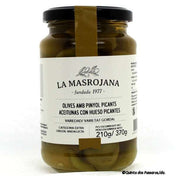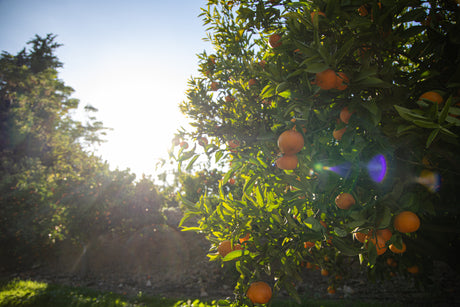Olive Week: Black and green treasures of Mediterranean cuisine
Olive Week is here – and what would it be without the aromatic fruits that have enriched our tables in countless varieties for millennia? Whether small or large, green or black, plain in a jar, in a fresh pack, or as a colorful olive mix: olives are versatile, delicious, and always a little bit of vacation on your plate. Let's delve into the fascinating world of olives together – with recipe ideas, curious facts, and interesting information!
From green to black – the variety of olives
Olives come in numerous varieties and sizes. The most striking difference is, of course, the color. Green and black olives are essentially the same fruit—they only differ in their ripeness. Green olives are harvested early, while black olives are allowed to ripen longer on the tree, developing their dark color.
Green olives : Often firmer to the bite and milder to slightly bitter in flavor. Perfect as antipasti, stuffed with peppers, almonds, or garlic.
Black olives : Softer, with a full-bodied flavor. Ideal for salads, pasta, or simply as a snack.
Whether natural, pitted, or stuffed—the selection is vast. Olives in jars or convenient freshness packs are particularly practical, making them ideal for snacking, cooking, or garnishing.
The olives we offer are produced according to the traditional methods of the region of origin, which have been passed down from generation to generation and have been preserved and improved over time.
Overview of the available varieties
Manzanilla
- Characteristics: Small to medium-sized, green, oval, with delicate, smooth skin.
- Flavor: Mild, slightly nutty, pleasantly salty. Often available stuffed (e.g., with peppers, almonds, garlic).
- Use: Classic for antipasti, salads, tapas or simply as a snack.
Gordal spicy
_ Characteristics: Very large, fleshy, green olive (hence the name "Gordal" = "the fat one").
- Taste: Mild, juicy and pleasantly spicy thanks to the spicy marinade.
- Use: Ideal for tapas, mixed appetizer platters, with cheese and wine or as a sophisticated snack.
Arbequina
- Characteristics: Small, round olive with thin skin.
- Taste: Very mild, fruity, slightly nutty with a subtle sweetness.
- Special feature: Arbequina olives are also highly valued as a basis for high-quality olive oils.
- Use: Perfect as a subtle accompaniment to salads, fish, seafood or mixed olive mixtures.
Black of Aragon
- Characteristics: Medium size, black-brown, slightly wrinkled skin due to air drying.
- Taste: Intensely aromatic, full-bodied, slightly salty, with a delicate bitter note.
- Use: Excellent on its own, with cheese, ham, wine or in Mediterranean dishes.
The combination of different varieties creates an exciting taste experience: from mild and fruity to spicy and intense – there is something for every olive lover.
Recipe ideas for Olive Week
To make olives shine not only as a snack but also as the star of the kitchen, here are a few delicious inspirations:
1. Mediterranean olive salad
Ingredients:
- Green and black olives (preferably mixed)
- Cherry tomatoes
- Red onion
- Feta cubes
- Fresh basil
- Olive oil, lemon juice, pepper
Preparation:
Combine all ingredients in a bowl, toss with olive oil and lemon juice, and season with pepper. The perfect summer salad is ready!
2. Pasta alla Puttanesca
Ingredients:
- Spaghetti
- Black olives
- Capers
- anchovies
- Garlic
- Passata
- chili flakes
- olive oil
Preparation:
Sauté garlic, anchovies, and chili flakes in olive oil, add tomatoes, olives, and capers, and simmer. Mix with the al dente spaghetti—a Mediterranean classic.
3. Olive Focaccia
Ingredients:
- Yeast dough
- Black and green olives
- Sea salt
- Rosemary
- olive oil
Preparation:
Roll out the dough on a baking sheet, spread the olives and rosemary on top, drizzle with olive oil, and sprinkle with sea salt. Bake in the oven until golden brown. Perfect as a side dish or snack.
Curious facts about the olive
- Botanically speaking, the olive is a stone fruit.
- The oldest known olive tree is in Crete and is estimated to be over 2,000 years old.
- In some cultures, olive trees are considered a symbol of peace, wisdom and constancy.
- There are over 1,000 different varieties of olives worldwide.
Useful information on storage and use
storage
- Unopened: Olives in jars, cans or fresh packaging can be kept for a long time at room temperature.
- Opened: Opened jars or packages should be refrigerated. Important: The olives should always be completely covered with liquid to prevent them from drying out or spoiling.
- Storage time: Once opened, ideally consume within 1-2 weeks to preserve the full flavor.
Tip: When the liquid becomes less, you can add some brine (water and salt) to extend the shelf life.
Bonus: The broth from olive jars is a wonderful base for dressings or marinades.
A little tip for gourmets:
Bring olives to room temperature before serving – this allows the aromas to develop particularly well.
Olive paste – the classic Mediterranean spread
Olive paste, also called tapenade, is a delicious way to bring the full flavor of olives to your plate. It's traditionally made from pitted olives (green or black), olive oil, and often other ingredients such as capers, anchovies, garlic, or herbs. The result is a spicy, spreadable paste with an intense flavor.
Possible uses:
- As a spread for baguette, ciabatta, crispbread or sailor biscuits
- For refining pasta, pizza or sandwiches
- As a dip for vegetables, grissini or cheese
- In marinades for meat, fish or grilled vegetables
- For flavoring salad dressings or sauces
Tip:
Olive paste tastes best at room temperature, when the flavors develop particularly well.
Conclusion:
Whether eaten on their own, refined in a sophisticated way, or as an aromatic side dish – olives are true all-rounders in the kitchen. Their variety offers something for every taste – from mild to spicy, from delicate to intense. Olive Week offers the perfect opportunity to discover new varieties and try out creative recipes. Enjoy!



